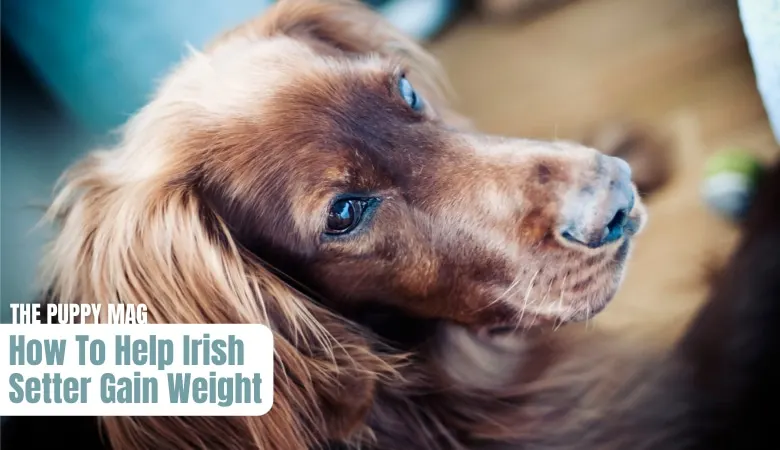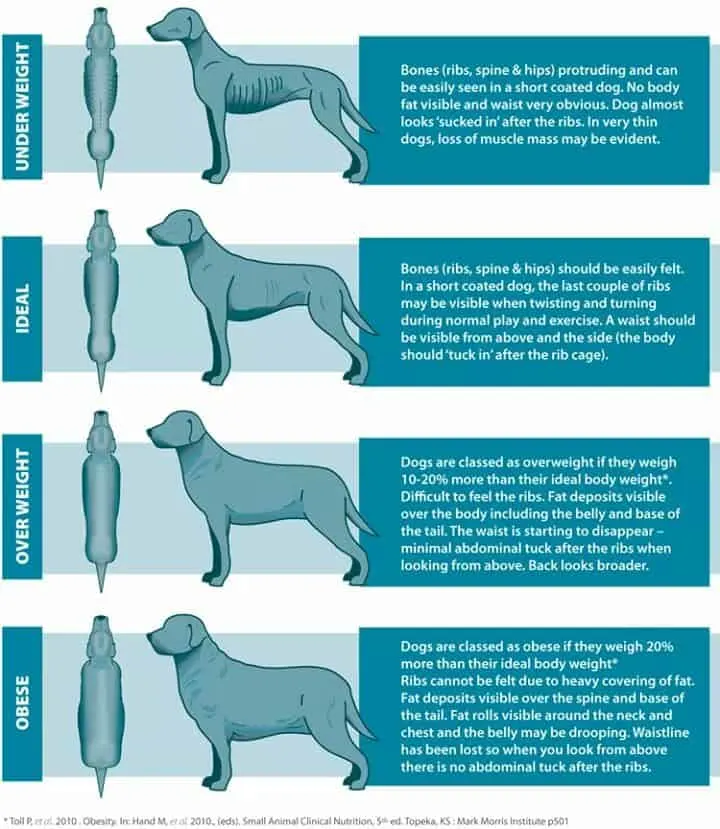5 Tips to help your Irish setter gain weight: after ruling out health concerns
- Mix a little wet dog food into his dry kibble (80% to 20% split)
- Add unsalted meat or meat broth into his kibble
- Add a tablespoon of peanut butter to his kibble
- Consider changing kibbles (higher calorie & better quality)
- Try time-restricted eating (for fussy eaters)
All will be explained fully and clearly, below.

Table of Contents
Is Your Irish Setter Actually Underweight?
Before getting too worried about your Irish setter’s weight, it’s necessary to consider what the average weight range is for a setter. After all, you may be worrying when you don’t need to, or you may find out that your setter is not that far away from “normal”.
● The average weight ranges for adult Irish setters:
Male: 64-74 Pounds (29-34 Kilograms)
Female: 55-64 Pounds (25-29 Kilograms)
How does your Irish setter compare in terms of his or her actual weight?
If you prefer judging by eye, this graph is very helpful (Used from Mel’s Mutts on FB)
The dog pictured below may not be an Irish setter, but it has a similar build and size therefore the same rules apply.

● One last thing. It’s also important to mention that some setters are just destined to be a little slimmer or skinnier than others. There’s a big difference between being a little slim, and drastically underweight.
● And for puppies. Puppy weight can be harder to gauge as some grow naturally faster than others during their growth spurts.
As long as some level of weight gain is consistent, month after months with your puppy, that’s usually fine. And remember, setters keep gaining weight until around 18 months old.
If you have an Irish setter puppy (under 1) that’s drastically skinny, waste no more time, and ask for advice from your local veterinarian.
5 Reasons Why Irish Setter Become Underweight
Depending on what’s causing your Irish setter to be underweight will impact what you should do about it.
It’s no good adding chicken broth or peanut butter like I suggested above if his weight issue isn’t being caused by food refusal or fussy eating… All causes will have their own appropriate solution.
1. Not eating his meals
Fussy eating or food refusal will lead to weight loss. Weight is a matter of calories in versus calories out, so if your setter is not eating his full meals, his body won’t be receiving the calories he needs.
Irish setters can be fussy eaters, and this can be caused by receiving too many treats or tidbits throughout the day, or just because he’s being difficult!
2. Lack of calories
He may be eating his meals, but the calories might not be enough. This could be due to the quality of his food and ingredients, the type of kibble or the portion size that he’s receiving.
3. Receiving too much exercise
He may be receiving the recommended amount of calories for his age and breed.
Still, if he’s receiving a lot more exercise than what’s considered normal (many hours of running per day) he’s probably burning more calories than he’s consuming, leading to weight loss. There’s always a balance between exercise and calories.
4. He doesn’t get on well with his diet
If his kibble isn’t quite right for him and is upsetting his stomach, he’ll be quick to refuse it, pick at it, and not really want to eat it.
It could be the quality of the food, or that your setter has a particular intolerance to a certain ingredient.
5. Underlying health issues
There is a range of underlying health issues that can affect appetite and weight. From thyroid issues, diabetes, parasites, and worms, there are many different problems that you will need to rule out first with your veterinarian.
Popular Irish Setter Articles:
● When Do Irish Setters Stop Growing?
● Can Irish Setters Make Good Family Dogs?
● Can Irish Setters Be Left At Home?
5 Ways To Help Your Irish Setter Gain Weight
Let’s run through 5 ways you can help your Irish setter gain weight at a healthy rate. Assuming you have already visited your veterinarian to rule out underlying health concerns, the following tips will certainly help.
Follow the 80% to 20% dry kibble and wet dog food mix.
⭐ Good for fussy eaters, adding calories, and boosting nutrition.
By adding in a small amount of wet dog food to his dry kibble, you will boost his overall nutrition, calories, and protein as well as make his food one billion times tastier! It’s important to remove a little kibble in replacement for the wet dog food, otherwise, you’ll be adding way too many calories.
Wet dog is very rich, has a higher protein and fat content, is more palatable for dogs, the meat is closer to its natural state and it contains far fewer preservatives and additives. It’s a winner. Many dry kibbles offer the same equivalent in wet dog food form, so that’s usually the best option for you to try.
Add plain-cooked meat and/or unsalted meat broth to his kibble
⭐ Good for fussy eaters, adding calories and protein.
If you don’t fancy trying the wet dog food option, this is your next best bet. By adding in some extra plain cooked meat as well as some unsalted meat broth (perhaps from your dinner) it should eliminate fussy eating issues almost immediately.
The tasty meat juice as well as the moisture will make his plain dry kibble come alive.
You also get the added benefit of high-quality protein and additional calories. This can be particularly good for those setters who receive a lot of exercise throughout the day as extra protein and calories help refuel and assist with weight gain and muscle growth.
Add a tablespoon of peanut butter to his meals
⭐ Good for fussy eaters, adding calories and those sensitive to common meats.
Peanut butter is another great way of adding extra healthy calories to your setter’s diet. Peanut butter has been deemed safe for dogs to eat, as long as it doesn’t contain xylitol or high salt. But you should always test a small amount first to rule out peanut allergies.
Peanut butter is a good alternative to the option before. Some setters are sensitive to common allergens, and it turns out that chicken, beef, lamb, and pork are all common allergens.
So adding more chicken or meat stock may not be the way to go. Peanut butter is very high in calories so it’s best to start off with a single tablespoon per day, every other day. And monitor his eating habits as well as the scales.
Consider changing kibbles
⭐ Necessary if your setter is disagreeing with his kibble
If you suspect your setter isn’t getting on very well with his kibble, or you are aware that it’s not of high-quality, it’s time to try something new. It’s really important to use only premium kibbles from reputable brands. Kibble varies greatly and the quality of ingredients can really impact your setter’s health.
To avoid upset stomachs, opt for a reputable brand that uses whole ingredients without any artificial preservatives, additives, by-products, or nasty fillers. Avoid high carbohydrate foods as these often cause a lot of inflammation and are a classic sign of low-quality.
Avoiding chicken, beef, lamb or pork-based kibbles may also be necessary. Despite being very common, these are all allergens and upset many stomachs.
Try opting for a quality kibble that uses salmon, duck, or turkey as the main protein source as these typically digest easier. To take it one step further, you could even try a kibble made for sensitive stomachs.
Whatever you choose, just ensure it is tailored for large working breeds like the Irish setter. That way, the calories, protein, and fat will be of an adequate level.
Time-restricted eating
⭐ Good to stop fussy eaters refusing their food (for no good reason).
If you know that your setter does get on well with his kibble and he’s just being darn fussy. Time-restricted eating is something you can try. This means removing his food bowl around 10 minutes after you put it down, whether the food is eaten, partially eaten, or not.
At first, this may shock your setter. But it will show him that food isn’t going to be available whenever he likes it. Avoid all treats and table scraps in between. By next mealtime (always use fresh kibble) your setter’s survival instincts should have definitely tweaked, especially if he didn’t touch his last meal. Again, 10 minutes only, before removing it.
You can safely do two removals, if he doesn’t eat on his third attempt, it will be time to call your veterinarian.
Does it really work? As many owners report, it actually does work. And according to behavioral experts, it triggers their survival instincts, and through removing the food, they quickly learn that food isn’t readily available, so the next time it comes, they eat it without fuss.
Some owners report this method instantly curing fussy eating habits for several months. They didn’t change the kibble or adjust anything else.
This should only be done if you are confident there are no underlying health issues, and your setter is purely being fussy for no good reason.
When To See a Veterinarian
As I mentioned above, the advice and help from your veterinarian is invaluable. They will always have the best opinion and are able to perform the necessary health checks.
⭐If your setter doesn’t eat for 2 days, call your veterinarian for further guidance.
⭐ If your setter refuses to drink anything, call your veterinarian as soon as possible.
Fluid intake becomes vitally important so if your setter is refusing to drink on top of refusing to eat, you will need some veterinary help as soon as possible to be on the safe side.
Remember, it’s never too early to ask for help from your veterinarian. It can be only too late.
Thank you for reading! I hope this has helped you understand a little more about why your Irish setter may be underweight and the appropriate solutions you can try. If you have any feedback, please let me know! Have a great day with your setter!
